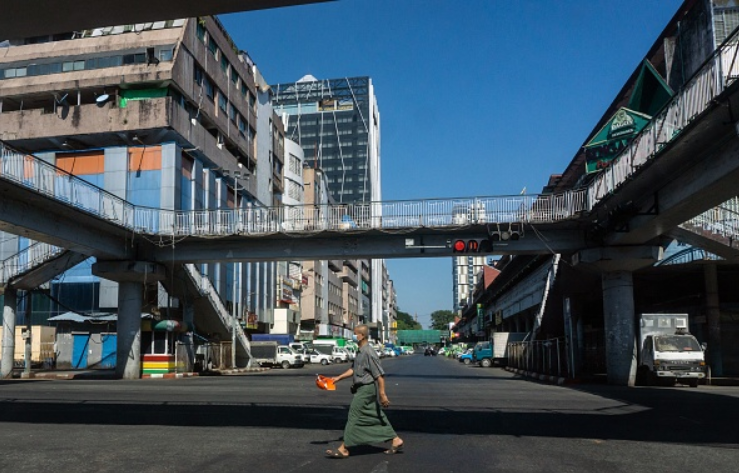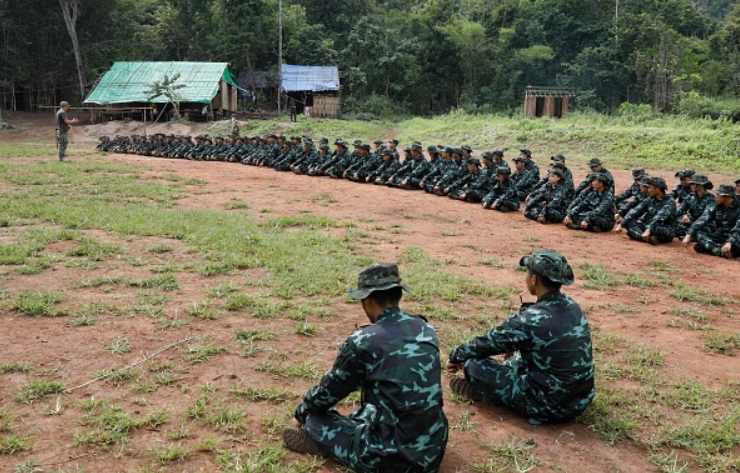
More than ten months after the coup and a protracted conflict that has produced a political and military stalemate, the struggle in Myanmar now extends to a battle for diplomatic recognition from multilateral global institutions, including the United Nations and the regional Association of Southeast Asian Nations (ASEAN). As the military and resistance forces associated with the National Unity Government (NUG) attempt to bleed one another on the battlefield raging within Myanmar, their representatives are vying to attract support from global leaders, who they hope will grant them the diplomatic recognition they need for their side to win.
In effect, Myanmar is not one state but many. On December 1, the UN Credentials Committee deferred a decision to recognize the junta’s preferred representative to the international body. The non-decision leaves Ambassador Kyaw Moe Tun, who was appointed before the coup but has pledged loyalty to the NUG and disavowed the military junta, with a seat—for now. The NUG has also appointed an ambassador to ASEAN and is eagerly meeting with foreign officials to make its case as the rightfully elected leaders of the country. But the coup in Myanmar has rent intractable faultlines through the polity, even dividing families whose loyalties are split between the military (the Tatmadaw) and the democratic opposition.
The Tatmadaw and its Many Enemies
The Tatmadaw has designated the NUG a “terrorist organsation” and indoctrinates young soldiers to view protesters as violent separatists who must be suppressed without hesitation. However, as many as 3,000 police and soldiers have reportedly defected from the military since the coup. Most of them say they have lost faith in the Tatmadaw and cannot countenance the further killing of civilians. Nonetheless, the military has launched a wave of violent raids against civilians and has even burned down villages suspected of harbouring opponents. Ongoing crackdowns around the country have reportedly left 220,000 people displaced since the coup.
At the same time, the NUG has erected a parallel state to coordinate humanitarian assistance and deliver pandemic relief and other emergency supplies. The NUG hopes that its ability to deliver public goods will translate into international goodwill, perhaps persuading foreign governments to confer it diplomatic recognition. Thus far, the European Parliament and the French Senate have both passed motions to support the NUG by recognising it as the legitimate representative of the Myanmar people.
But to characterize the crisis as a two-dimensional battle between the military and a unified resistance grossly oversimplifies the intersection of myriad, decades-long conflicts that have plagued Myanmar since independence from Britain in 1948.
The coup has also left thousands of Myanmar citizens stranded overseas on temporary protected status visa extensions. Many young students and professionals trying to make a better life outside their home country had hoped to return to Myanmar to contribute to its democratic progress. Now, they feel it is their duty to spread awareness about the military’s abuses, raise funds for the civil disobedience movement, and mobilise international pressure against the coup. Their posts on social media, which the regime scours diligently in the hopes of identifying and tracking the resistance’s support networks, make them potential targets of the military’s repression if they return home.
But to characterize the crisis as a two-dimensional battle between the military and a unified resistance grossly oversimplifies the intersection of myriad, decades-long conflicts that have plagued Myanmar since independence from Britain in 1948. There are more than a dozen different ethnic armed groups in the country that have been contesting the military’s efforts to consolidate control over the state for decades. The majority have been reluctant to throw their support behind the NUG, which they view as merely another central Burman rival to the military rather than a genuinely inclusive, federal movement that will respond to its interests and long-held grievances.

Descent into Chaos: Is the Military Losing?
The country has come close to resolving some of its largest conflicts a couple of times in its history: first in the early 1990s under the direction of fabled spy chief Khin Nyunt, who oversaw the conclusion of ceasefires with a number of ethnic armed groups, and later in 2015, when the reformist government of retired general Thein Sein achieved a Nationwide Ceasefire Accord with eight of fifteen different groups involved in negotiations.
The progress made under Thein Sein’s administration (2011-2016) broke down when Aung San Suu Kyi’s National League for Democracy replaced the negotiating team with her own peace process. Many ethnic minorities still distrust Suu Kyi and her party, the NLD, and see her as just another ruler from the Bamar ethnic majority group with little concern for their interests. Some of this mistrust is tied to historical perceptions of her father, the founder of the Burma military, or Tatmadaw, that has been killing their people and driving them from their homes for decades.
Today, the military continues to weaponize racial divisions to suit its purposes of divide and rule. The Tatmadaw seeks to avoid fighting an all-out battle against the country’s disparate ethnic armed groups simultaneously. Rather, it grants concessions to some while waging war on others in far-flung parts of the country so that it maintains an asymmetric advantage. For instance, it has made strenuous efforts to placate the powerful Arakan Army (AA) in Rakhine State, with whom it concluded a ceasefire agreement in 2020, by releasing prisoners and lifting the ‘terrorist organisation’ designation it had placed on the group.
Today, the military continues to weaponize racial divisions to suit its purposes of divide and rule.
There are now signs that the ceasefire may be breaking down, as the Tatmadaw moves more troops to the restive Rakhine State in advance of potential conflict. If conflict with the AA resumes, it could spell a dangerous new phase in Myanmar’s multidimensional civil war or even overstretch the military, which is already being tested. Keeping a lid on urban protest movements along with spiralling conflicts across the country is frustrating the military’s command structure. As many as 500 different People’s Defence Forces (PDF) have reportedly sprung up around the country, only some of which report to the National Unity Government.
The NUG claims to have killed nearly 3,000 of the military’s soldiers in recent months, though the junta disputes this figure and say real casualties are much lower. The truth is likely somewhere between the two. As internal conflicts escalate and groups currently on the sidelines consider joining the fray to test the military’s weakness, there is a real and imminent risk of even greater loss of lives. The military appears prepared to unleash violence of truly hellish proportions, believing it must win at all costs.
Senior General Min Aung Hlaing, the leader of the junta, or State Administrative Council (SAC), is presiding over a failing state, while the economy, which was already struggling enormously with COVID, is in freefall. According to the World Bank, Myanmar’s economy contracted by as much as 18 percent in 2021, and the United Nations has warned that three million people are in urgent need of food and humanitarian assistance to protect them from other natural disasters.
The International Community’s Failure to Respond
Meanwhile, the international response is in disarray. ASEAN continues to dither. In October it made the historic decision to bar Senior General Min Aung Hlaing from attending a major summit at the end of the month, insisting that the junta could send a “non-political representative”. The generals rebuffed this suggestion and chose to boycott the meetings instead. However, the move accomplished little more than scoring symbolic points. Its special envoy, Bruneian diplomat Erywan Yusof, has been stymied by the junta and failed to secure access to representatives of the NUG.
Until some sort of political solution is achieved, Myanmar’s civilian population will remain torn between the current chaos of poverty and armed conflict on the one hand, and an as-yet-unrealised future built on principles of democracy and federalism towards which they are striving.
With Cambodia assuming ASEAN chairmanship for the next year, it appears that the junta is in for easier days. Cambodian leader Hun Sen has signalled interest in visiting Min Aung Hlaing in Naypyidaw in January and has argued that ASEAN should include the junta in its meetings. “It’s a family member of ASEAN, they must have the rights to attend meetings”, he said in early December. However, it is likely that other ASEAN states, such as Indonesia, the Philippines, and Singapore, will object to efforts to include the military’s representatives. As a result, hopes of an ASEAN-led process to initiate negotiations between the NUG and SAC are misplaced. The regional bloc’s internal divisions have proven too wide for it to forge a consensus and speak with one voice, allowing the junta in Naypyidaw to benefit from ASEAN’s disunity.
Staring into the Abyss: Is There Any Way Forward?
Deprived of a seat at the United Nations and facing targeted economic sanctions from the United States Treasury and the European Union, the junta remains isolated on the world stage. And while it has the upper hand on the battlefield at the moment, it has suffered steady casualties from clashes with PDF forces, who claim to have killed more than 1,500 soldiers between September and October alone.
Until some sort of political solution is achieved, Myanmar’s civilian population will remain torn between the current chaos of poverty and armed conflict on the one hand, and an as-yet-unrealised future built on principles of democracy and federalism towards which they are striving. Many of those fighting for those ideals believe such a future is impossible without the complete dissolution of the military, which remains the crucial roadblock to genuine democratization and sustainable peace. For the majority of young people across the country, there is no going back.
Editor’s Note: A version of this piece originally appeared on 9DashLine and has been republished with permission from the editors.
***
Image 1: STR/AFP via Getty Images
Image 2: STR/AFP via Getty Images


